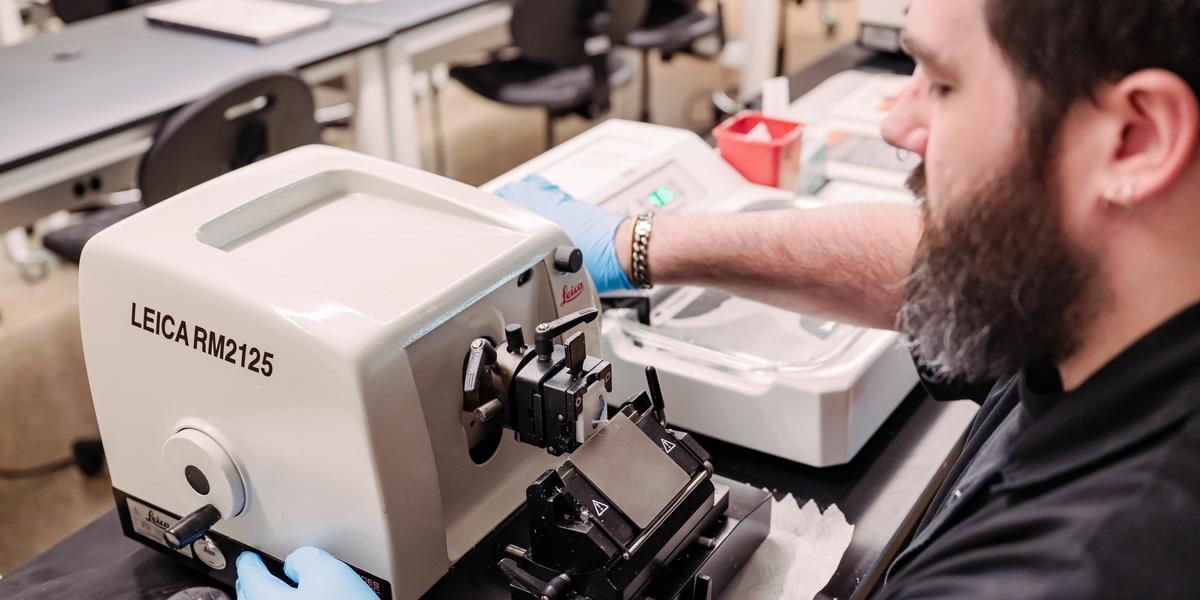
Our mission is to train and develop high-quality histotechnicians. Histotechnicians are members of the laboratory team who prepare specimens for research or medical diagnosis by pathologists. They work with fragile, delicate tissue specimens, laboratory instruments, knives, chemicals and glass slides, all of which require mastery of skills and competency. We are dedicated to providing comprehensive education and hands-on training that prepares students to excel in this field that is experiencing increased demand.
Our program focuses on equipping students with the technical skills, critical thinking abilities and problem-solving capabilities required to become proficient histotechnicians. With a strong emphasis on quality, we strive to produce graduates who are well-prepared, competent and capable of delivering exceptional histotechnology services.
The program goals include:
Through these goals, the program strives to produce competent and certified histotechnicians equipped with the necessary skills and knowledge to contribute to the field of histotechnology.
Our mission is to train and develop high-quality histotechnicians. Histotechnicians are members of the laboratory team who prepare specimens for research or medical diagnosis by pathologists. They work with fragile, delicate tissue specimens, laboratory instruments, knives, chemicals and glass slides, all of which require mastery of skills and competency. We are dedicated to providing comprehensive education and hands-on training that prepare students to excel in this field that is experiencing increased demand.
The Histotechnician program outcomes are designed to align, correlate and support National Accrediting Agency for Clinical Laboratory Sciences (NAACLS) entry-level competencies including both core and unique standards for the profession. Upon successful completion of this program, students will be able to:
Histotechnology is a hands-on, detail-oriented field that requires strong visual, motor and physical abilities. Students entering the Histotechnician program should be prepared to meet the essential functions outlined below. These abilities are necessary for safe and effective performance in both academic and clinical histology laboratory settings.
Required Skills and Abilities
Accessibility and Accommodations
If you have a limitation in any of the above areas, we encourage you to speak with the program director prior to applying. Students with documented disabilities are entitled to support through AACC’s Disability Support Services.
Contact for Questions or Concerns
Applicants who have questions about these essential functions or who may require an accommodation are encouraged to contact the Histotechnician program director directly for guidance.
AACC is currently pursuing program accreditation status through the National Accrediting Agency for Clinical Laboratory Sciences (NAACLS). This accreditation is a testament to our commitment to providing the highest quality education in the field of histotechnology. For details or inquiries related to AACC’s accreditation status, contact:
National Accrediting Agency for Clinical Laboratory Sciences (NAACLS)
5600 N. River Road, Suite 720
Rosemont, IL 60018-5119
Phone: 773-714-8880
Fax: 773-714-8886
info@naacls.org
All students enrolled in the Histotechnician program at AACC are required to complete two clinical courses in their final spring semester:
Each course includes a supervised clinical rotation at an approved affiliate site, providing students with hands-on experience in histotechnology laboratories. The combined 320 hours of clinical training ensures students develop proficiency in routine histology procedures, special staining and laboratory workflow in real-world settings.
Should the number of students exceed the number of available clinical placements, students may be deferred and scheduled for placement in early summer. The program director assigns students to clinical sites based on availability and program objectives.
Clinical Site Disclosure
Clinical Rotation Orientation and Syllabus
Prior to starting clinical rotations, students receive a detailed syllabus for each clinical course that outlines:
The program director also verifies that all health and safety documentation has been completed and submitted to the clinical affiliate site before the student begins clinical training.
Class of 2025
Graduation Rate: 100%
Attrition Rate: 0%
Job Placement Rate: Data not yet available. Job placement outcomes will be reported once one full year has passed since graduation.
Information related to the Histotechnician (HTC) program’s clinical affiliates and/or policies and procedures related to students is provided during the HTC program's information sessions and it is provided to students in their handbooks. For more information contact:
Briana Zeck MS, HTL (ASCP)
Program Director
410-777-7239
blzeck@aacc.edu
To learn more about histotechnology, visit:
To learn more about how to become a credentialed histotechnician, visit: